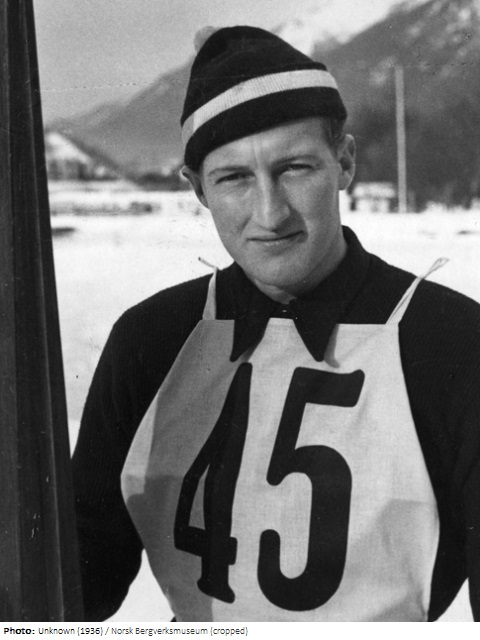Reidar Andersen

Biographical information
| Roles | Competed in Olympic Games • Non-starter |
|---|---|
| Sex | Male |
| Full name | Reidar•Andersen |
| Used name | Reidar•Andersen |
| Born | 20 April 1911 in Norderhov, Ringerike, Viken (NOR) |
| Died | 15 December 1991 in Oslo, Oslo (NOR) |
| Measurements | 180 cm |
| Affiliations | Sportsklubben Freidig, Trondheim (NOR) |
| NOC |  Norway Norway |
| Medals | OG |
| Gold | 0 |
| Silver | 0 |
| Bronze | 1 |
| Total | 1 |
Biography
Reidar Andersen was only surpassed by Birger Ruud as Norway’s leading ski jumper in the 1930s. He would never win an international title as Ruud did on several occations, but Andersen is still the only ski jumper to win Holmenkollen three years in a row (1936-38), the same years he was also Norwegian Champion. His breakthrough came in 1930 when at age 18 he won a silver medal at the World Championships on home ground in Holmenkollen. Five years later he was second again, narrowly beaten by Birger Ruud. After his bronze medal in the 1936 Winter Olympics (won by Ruud), he won another silver at the 1937 World Championships, this time also with Ruud at the top of the rostrum. Andersen was the favorite for the gold in the same championships in 1938 in Lahti, Finland after impressive training jumps. However, the day before the competition he strained an ankle during a cross-country skiing trip, and was only able to place fifth in the competition, while the youngest of the Ruud brothers, Asbjørn, became world champion.
Reidar Andersen was known for his stylish jumps, and was the first ever jumper to be awarded maximum style points of 20 when winning at Holmenkollen in 1938. He was elegant in all ways, always using white gloves in competitions. But he was also able to make long jumps, holding the hill record at Holmenkollen for several years. In 1934 the world’s largest ski jumping hill was opened in Planica, Yugoslavia, and Birger Ruud jumped a new world record of 92.5 m. The year after four Norwegian ski jumpers, among them Reidar Andersen, were invited to participate. The day before the competition Andersen jumped a new world record of 99.5 m, and was confident that he would be the first man to pass 100 m in the competition next day. The Norwegian Ski Association was however afraid of the new big hills and feared for the jumpers’ safety, so the Norwegian jumpers were denied the chance to start, and had to watch the competition from the stands. The next winter, with no Norwegians present, the Austrian Sepp Bradl became the first man to surpass the 100 m mark, improving the world record to 101.5 m.
In 1939 Andersen went to the United States to promote skiing, and made several jumping exhibitions in cities like San Francisco and Los Angeles. After the war he placed third in the 1946 Norwegian Championships. At the 1948 Olympics he was coach for the Norwegian ski jumping team. He was also a successful businessman, establishing a firm producing sports articles. Andersen was famous for designing the first mountain anorak, especially known for its practical chest pocket. His great grandson Simen Spieler Nilsen was one of Norway’s most promising junior speed skaters, as a member of the Norwegian team in Team Pursuit he was Junior World Champion in Moscow 2010 and Obihiro 2012. He competed at the 2014 and 2018 Winter Olympics, and won a gold medal as a member of the Norwegian time pursuit team in 2018.
Results
| Games | Discipline (Sport) / Event | NOC / Team | Pos | Medal | As | |
|---|---|---|---|---|---|---|
| 1932 Winter Olympics | Ski Jumping (Skiing) |  NOR NOR |
Reidar Andersen | |||
| Large Hill, Individual, Men (Olympic) | ||||||
| 1936 Winter Olympics | Ski Jumping (Skiing) |  NOR NOR |
Reidar Andersen | |||
| Large Hill, Individual, Men (Olympic) | 3 | Bronze |
Special Notes
- Listed in Olympians Who Were Awarded the Holmenkollmedaljen (1938)
- Listed in Olympians Who Won a Medal at the World Nordic Ski Championships (0–3–1 1930 Oslo SJP silver: normal hill; 1935 Vysoké Tatry SJP silver: normal hill; 1936 Garmisch-Partenkirchen (Olympics) SJP bronze: normal hill; 1937 Chamonix SJP silver: normal hill)